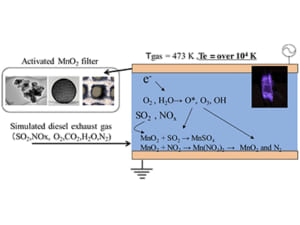Mar 8 2019
A Japan-based research group headed by Kanazawa University has almost entirely removed SOx and NOx from diesel exhaust gas at a low temperature of 473 K by employing ozone from an atmospheric-pressure non-equilibrium plasma along with the desulfurization catalyst MnO2.
 (Image credit: Kanazawa University)
(Image credit: Kanazawa University)
This study demonstrates that ozone can be used to eliminate SOx as well as NOx from fossil fuel combustion exhaust streams.
Diesel engines are extensively employed in vehicles, agricultural machinery, and ships due to their high thermal efficiency. Through combustion, sulfur present in the diesel fuel is oxidized to sulfur dioxide. Apart from affecting human health, sulfur dioxide also leads to deactivation of the catalysts employed to treat NOx in the exhaust stream.
This issue can be solved by using biomass-based, sulfur-free fuels or clean coal technology, or by setting up a desulfurizing filter to eliminate sulfur oxides upstream of the NOx catalyst. Scientists at Kanazawa University have created a plasma-assisted MnO2 filter that makes the exhaust gas free from NOx and SOx. This technology enhances the desulfurization properties of MnO2 with the activity of ozone from an atmospheric-pressure non-equilibrium plasma. Activated chemical species (OH radicals, O3, and so on) contained in the plasma advance desulfurization and denitration reactions.
Results
MnO2 reacts with sulfur to form sulfates and with nitrogen oxides to form nitrates. The performance of MnO2 catalysts in eliminating SO2 and NO2 is degraded by the interaction between the species. Prof. Huang of the Guangzhou Institute of Energy Conversion examined the MnO2 catalyst material after subjecting it to simulated exhaust gas composed of SO2 as well as NO2 and discovered that both manganese sulfate and manganese nitrate were produced.
The research team assessed the effect of ozone on the performance of the catalyst for SO2 and NO2 removal. The dielectric barrier discharge technique was used to produce an atmospheric-pressure non-equilibrium plasma. The introduction of ozone at a low concentration of about 50 ppm enhanced the performance of the catalyst in removing both SO2 and NO2. The improvement in NO2 elimination was predominantly remarkable. The introduction of ozone appears to result in a reaction that reduces nitrogen oxides to nitrogen.
At the initial stage of the reaction, more than 99% of SO2 and NO2 were eliminated from the exhaust stream. The Kanazawa University research team, headed by Yugo Osaka, established for the first time that zero emissions of NOX can be realized even in the presence of sulfur oxides by using a plasma-assisted MnO2 filter. The plasma-assisted filter appears to boost the elimination of SO2 due to SO3 generation and also reduces nitrogen oxides to nitrogen.
Future prospects
These findings are thought to be extensively applicable in the purification of exhaust from diesel engines that use sulfur-containing fuels. The team has refined the mechanism by which the induction of the non-equilibrium plasma promotes the performance of the MnO2 filter. The team hopes to drive further development of plasma-assisted MnO2 filters and thereby enable a larger diversity of fuels to be used without negatively affecting air quality.